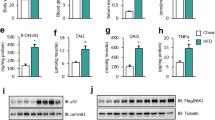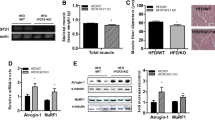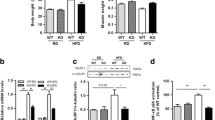Abstract
NF-κB is a transcription factor implicated in pathological responses that develop during diabetes mellitus, including skeletal muscle atrophy. Given that NF-κB activation, protein composition, and content within diabetic skeletal muscle remain generally uncharacterized, a streptozotocin (STZ) model was used to assess NF-κB activation, composition, and content. Sprague-Dawley rats were injected with STZ (55 mg/kg) and after 30 days the soleus (SOL), plantaris (PL), red gastrocnemius (RG), and white gastrocnemius (WG) muscles were assessed by electrophoresis mobility shift assay and western blotting. NF-κB activation was detected in all muscles examined, but was reduced in RG muscles from diabetic animals. Supershifts indicated NF-κB was composed primarily of p50 in diabetic and control animals. The content of both p65 and p52 was elevated in SOL and PL muscles, while p52 was decreased in RG. The coactivating protein, Bcl-3, was increased in WG and RG, but decreased in PL. Both p50 and RelB remained unchanged in all tissues examined. All muscles from diabetic animals demonstrated reduced mass when compared to controls, but only the gastrocnemius demonstrated atrophy as reflected by a reduced muscle-to-body mass ratio. In conclusion, diabetic alterations to the contents and activation of the NF-κB protein were tissue-specific, but did not appear to alter dimer composition of constitutively bound NF-κB. These results indicate that diabetes may alter NF-κB activity and expression in a muscle-specific manner.







Similar content being viewed by others
References
Armstrong RB, Laughlin MH (1985) Metabolic indicators of fibre recruitment in mammalian muscles during locomotion. J Exp Biol 115:201–213
Armstrong RB, Gollnick PD, Ianuzzo CD (1975) Histochemical properties of skeletal muscle fibers in streptozotocin-diabetic rats. Cell Tissue Res 162:387–394
Bosisio D, Marazzi I, Agresti A, Shimizu N, Bianchi ME, Natoli G (2006) A hyper-dynamic equilibrium between promoter-bound and nucleoplasmic dimers controls NF-kappaB-dependent gene activity. EMBO J 25:798–810
Cai D, Frantz JD, Tawa NE Jr, Melendez PA et al (2004) IKKbeta/NF-kappaB activation causes severe muscle wasting in mice. Cell 119:285–298
Chaudhury SK, Mandal MB, Deshpande SB, Saxena ID (1994) Effect of streptozotocin-induced diabetes on growth and proteolytic activity of different muscles in rats. Indian J Exp Biol 32:877–880
Chen V, Ianuzzo CD (1982) Dosage effect of streptozotocin on rat tissue enzyme activities and glycogen concentration. Can J Physiol Pharmacol 60:1251–1256
Cogswell PC, Scheinman RI, Baldwin AS Jr (1993) Promoter of the human NF-kappa B p50/p105 gene. Regulation by NF-kappa B subunits and by c-REL. J Immunol 150:2794–2804
Derudder E, Laferte A, Ferreira V, Mishal Z, Baud V, Tarantino N, Korner M (2003) Identification and characterization of p100HB, a new mutant form of p100/NF-kappa B2. Biochem Biophys Res Commun 308:744–749
Engstrom G, Stavenow L, Hedblad B, Lind P, Eriksson KF, Janzon L, Lindgarde F (2003) Inflammation-sensitive plasma proteins, diabetes, and mortality and incidence of myocardial infarction and stroke: a population-based study. Diabetes 52:442–447
Fan C, Yang J, Engelhardt JF (2002) Temporal pattern of NFkappaB activation influences apoptotic cell fate in a stimuli-dependent fashion. J Cell Sci 115:4843–4853
Gilmore TD (2006) Introduction to NF-kB: players, pathways, perspectives. Oncogene 25:6680–6684
Guttridge DC, Mayo MW, Madrid LV, Wang CY, Baldwin AS Jr (2000) NF-kB-induced loss of MyoD messenger RNA: possible role in muscle decay and cachexia. Science 289:2363–2366
Hoffmann A, Natoli G, Ghosh G (2006) Transcriptional regulation via the NF-kappaB signaling module. Oncogene 25:6706–6716
Hunter RB, Kandarian SC (2004) Disruption of either the Nfkb1 or the Bcl3 gene inhibits skeletal muscle atrophy. J Clin Invest 114:1504–1511
Hunter RB, Stevenson E, Koncarevic A, Mitchell-Felton H, Essig DA, Kandarian SC (2002) Activation of an alternative NF-kappaB pathway in skeletal muscle during disuse atrophy. FASEB J 16:529–538
Kaliman P, Canicio J, Testar X, Palacin M, Zorzano A (1999) Insulin-like growth factor-II, phosphatidylinositol 3-kinase, nuclear factor-kappaB and inducible nitric-oxide synthase define a common myogenic signaling pathway. J Biol Chem 274:17437–17444
Kashatus D, Cogswell P, Baldwin AS (2006) Expression of the Bcl-3 proto-oncogene suppresses p53 activation. Genes Dev 20:225–235
Kefaloyianni E, Gaitanaki C, Beis I (2006) ERK1/2 and p38-MAPK signalling pathways, through MSK1, are involved in NF-kappaB transactivation during oxidative stress in skeletal myoblasts. Cell Signal 18:2238–2251
Laemmli UK (1970) Cleavage of structural proteins during the assembly of the head of bacteriophage T4. Nature 227:680–685
Lecker SH, Jagoe RT, Gilbert A et al (2004) Multiple types of skeletal muscle atrophy involve a common program of changes in gene expression. FASEB J 18:39–51
Lee SW, Dai G, Hu Z, Wang X, Du J, Mitch WE (2004) Regulation of muscle protein degradation: coordinated control of apoptotic and ubiquitin-proteasome systems by phosphatidylinositol 3 kinase. J Am Soc Nephrol 15:1537–1545
Liptay S, Schmid RM, Nabel EG, Nabel GJ (1994) Transcriptional regulation of NF-kappa B2: evidence for kappa B-mediated positive and negative autoregulation. Mol Cell Biol 14:7695–7703
Locke M, Tanguay RM (1996) Increased HSF activation in muscles with a high constitutive Hsp70 expression. Cell Stress Chaperones 1:189–196
Locke M, Tanguay RM, Klabunde RE, Ianuzzo CD (1995) Enhanced postischemic myocardial recovery following exercise induction of HSP 72. Am J Physiol 269:320–325
Lowry OH, Rosebrough NJ, Farr AL, Randall RJ (1951) Protein measurement with the Folin phenol reagent. J Biol Chem 193:265–275
McFarlane C, Plummer E, Thomas M et al (2006) Myostatin induces cachexia by activating the ubiquitin proteolytic system through an NF-kappaB-independent, FoxO1-dependent mechanism. J Cell Physiol 209:501–514
Mourkioti F, Kratsios P, Luedde T et al (2006) Targeted ablation of IKK2 improves skeletal muscle strength, maintains mass, and promotes regeneration. J Clin Invest 116:2945–2954
Nishikawa T, Edelstein D, Du XL et al (2000) Normalizing mitochondrial superoxide production blocks three pathways of hyperglycaemic damage. Nature 404:787–790
Phillips T, Leeuwenburgh C (2005) Muscle fiber specific apoptosis and TNF-alpha signaling in sarcopenia are attenuated by life-long calorie restriction. FASEB J 19:668–670
Price SR, Bailey JL, Wang X, Jurkovitz C, England BK, Ding X, Phillips LS, Mitch WE (1996) Muscle wasting in insulinopenic rats results from activation of the ATP-dependent, ubiquitin-proteasome proteolytic pathway by a mechanism including gene transcription. J Clin Invest 98:1703–1708
Rebollo A, Dumoutier L, Renauld JC, Zaballos A, Ayllon V, Martinez-A C (2000) Bcl-3 expression promotes cell survival following interleukin-4 deprivation and is controlled by AP1 and AP1-like transcription factors. Mol Cell Biol 20:3407–3416
Schwarz EM, Krimpenfort P, Berns A, Verma IM (1997) Immunological defects in mice with a targeted disruption in Bcl-3. Genes Dev 11:187–197
Shiio Y, Sawada J, Handa H, Yamamoto T, Inoue J (1996) Activation of the retinoblastoma gene expression by Bcl-3: implication for muscle cell differentiation. Oncogene 12:1837–1845
Smahi A, Courtois G, Vabres P et al (2000) Genomic rearrangement in NEMO impairs NF-kappaB activation and is a cause of incontinentia pigmenti. The International Incontinentia Pigmenti (IP) Consortium. Nature 405:466–472
Tong X, Yin L, Washington R, Rosenberg DW, Giardina C (2004) The p50-p50 NF-kappaB complex as a stimulus-specific repressor of gene activation. Mol Cell Biochem 265:171–183
Towbin H, Staehelin T, Gordon J (1979) Electrophoretic transfer of proteins from polyacrylamide gels to nitrocellulose sheets: procedure and some applications. Biotechnology 24:145–149
Wyke SM, Tisdale MJ (2005) NF-kappaB mediates proteolysis-inducing factor induced protein degradation and expression of the ubiquitin-proteasome system in skeletal muscle. Br J Cancer 92:711–721
Xiao G, Harhaj EW, Sun SC (2001) NF-kappaB-inducing kinase regulates the processing of NF-kappaB2 p100. Mol Cell 7:401–409
Yerneni KK, Bai W, Khan BV, Medford RM, Natarajan R (1999) Hyperglycemia induced activation of nuclear transcription factor kappaB in vascular smooth muscle cells. Diabetes 48:855–864
Yui MA, Rothenberg EV (2004) Deranged early T cell development in immunodeficient strains of nonobese diabetic mice. J Immunol 173:5381–5391
Author information
Authors and Affiliations
Corresponding author
Rights and permissions
About this article
Cite this article
Frier, B.C., Noble, E.G. & Locke, M. Diabetes-induced atrophy is associated with a muscle-specific alteration in NF-κB activation and expression. Cell Stress and Chaperones 13, 287–296 (2008). https://doi.org/10.1007/s12192-008-0062-0
Received:
Revised:
Accepted:
Published:
Issue Date:
DOI: https://doi.org/10.1007/s12192-008-0062-0




